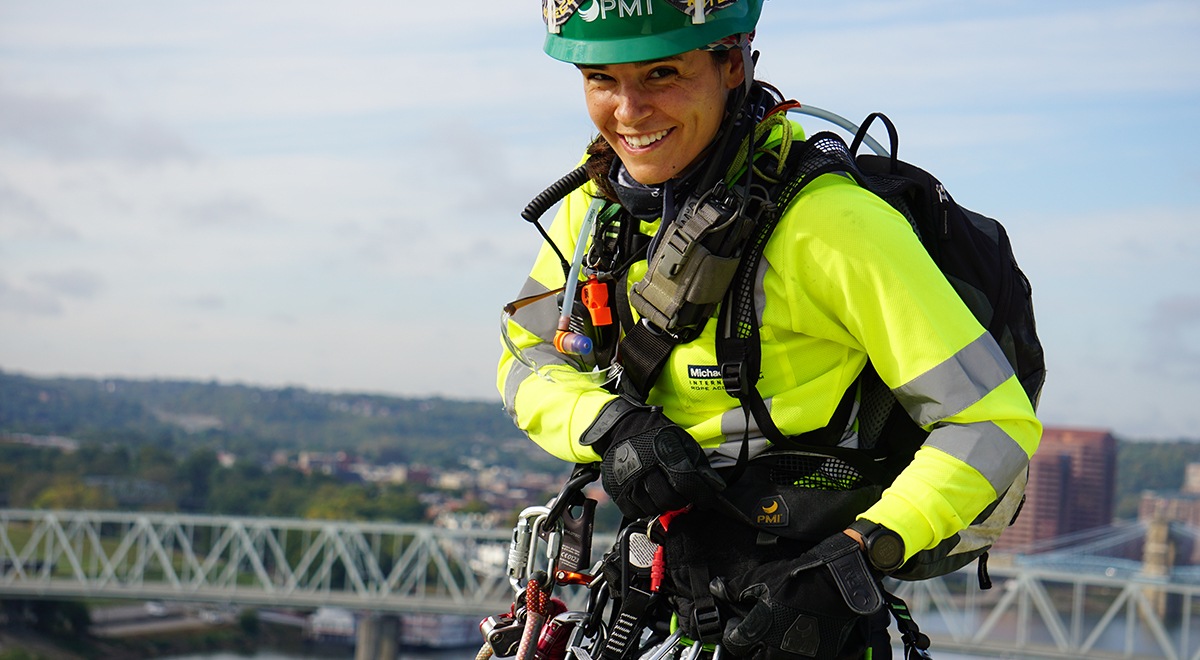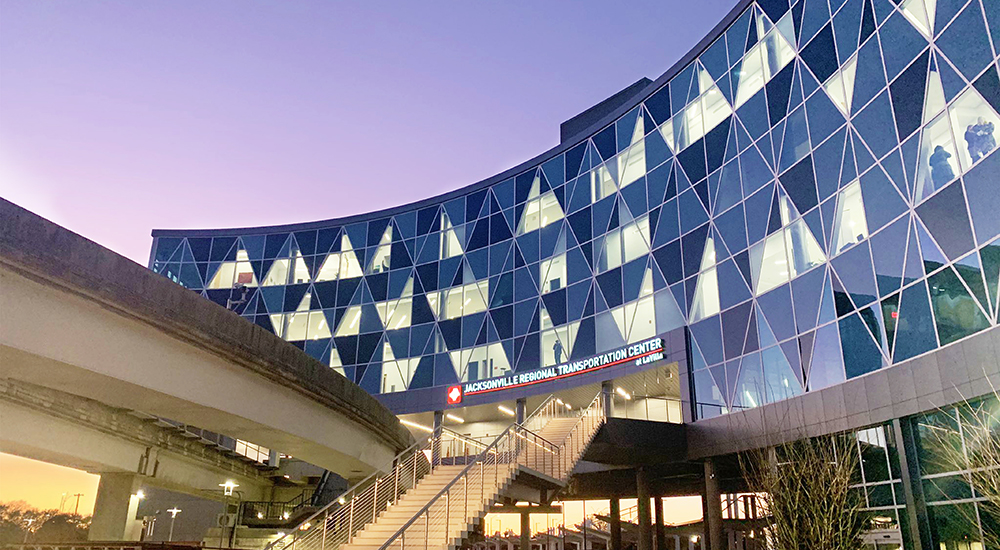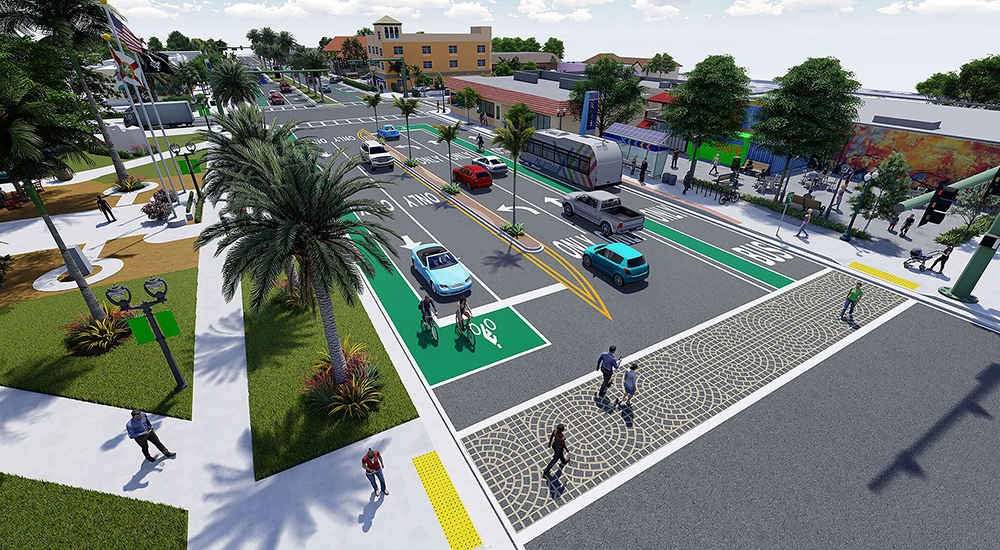Michael Baker helps Florida’s Merritt Island Airport extend its runway safety area farther into the river while preserving and upgrading the natural habitat around it
From the Spring 2017 issue of Signature
Sunken and abandoned boats. Dead seagrass. Invasive plant species, mosquitos, hungry manatees, disturbed alligator habitat, an unexploded World War II bomb and an airport with a need to extend its short and fast-eroding runway safety area farther into the river around it.
All in a day’s work for Michael Baker International’s Florida-based team of aviation engineers and environmental scientists. Armed with airboats, pontoons, waders, seagrass seedlings, years of aviation and environmental know-how and caring local partners, this team has helped Merritt Island Airport make its runway safer – while ensuring the sustainability of the airport, the inland waterway, its shoreline, and the wildlife and flora around it.
Merritt Island Airport, owned and operated by the Titusville Cocoa Airport Authority (TICO), sits within the environmentally sensitive Banana River Aquatic Preserve, not far from Cape Canaveral and Cocoa Beach along the east coast of the Florida peninsula. This public-use, general-aviation airport occupies 129 acres and boasts a single 3,601-foot-long runway and safety area, which is partially surrounded by the Banana River and extends approximately 1,000 feet into Newfound Harbor.
SEVENTY YEARS OF EROSION
The problem with the airport, according to Michael Powell, chief executive officer of the Titusville-Cocoa Airport Authority, was that the runway’s safety area, which jutted into the river, had suffered erosion along the riverbank over the years – as much as one foot a year, in fact. The runway area ended approximately 60 feet from the water’s edge, falling short of the current 240-foot safety area required by the Federal Aviation Administration beyond the end of the runway.
“We had seen the required runway safety area slowly eroding away over many years along its shores in the Banana River,” says Powell. “While the Airport Authority needed to ensure the safest environment possible for our valued tenants and the traveling public, we also were very cognizant of the possible delicate environmental impacts of our needed improvements and sought to exceed requirements.
“Airports – especially those embedded into a natural environment or shoreline – must be cognizant of the negative impact that improvements can have on the natural surroundings,” Powell continues. “Due to the unique positioning of our runway, as we embarked on this project, we were duly aware that it must not only aid in passenger safety, but also have limited negative impact on the environment.”
TICO turned to Michael Baker to find a solution that would effectively strike a reasonable balance between ensuring airline passenger safety and good environmental stewardship. Michael Baker, in addition to providing environmental analyses, mitigation plans, restoration, engineering, construction management and other services, also helped the airport up front to secure the necessary permits to initiate and complete the project.
“TICO challenged Michael Baker to design a runway improvement project that would not only mitigate the unavoidable environmental impacts but also help improve the ailing Banana River,” says Mariben Andersen, a Tampa-based environmental manager with Michael Baker’s environmental practice. “So the team was able to take a project that seemed to have seen some damage to area wildlife and turn it into something that has benefitted the environment. Fisheries had dropped significantly, and seagrass was dying. There were many unintended consequences. We were able to repair a lot of that.”
MANY ENVIRONMENTAL CHALLENGES … AND STAKEHOLDER GROUPS
Make no mistake, safety concerns loomed large at Merritt Island. From 1988 to 2014, the airport suffered 34 reported incidents of airplanes rolling off the runway, resulting in aircraft damage and minor injuries. As a result, the Runway Safety Area (RSA) needed to be extended by 185 feet to meet current FAA design standards. That, of course, created a host of other challenges for the Michael Baker team to address.
Additional project design consideration included the following:
- Sustainability remained a key driver, with design sufficient to withstand a 100-year storm, and the resulting structures built to enjoy a life span of 75-plus years.
- The design would need to consider the mitigation of habitat damage, since the RSA would have to extend into an existing nature preserve, producing unavoidable damage to seagrass habitat.
- The design had to incorporate measures to prevent further shoreline erosion and passively accommodate the management of stormwater runoff.
- The Michael Baker team would have to design the project to minimize any environmental impact on a nearby shellfish harvesting area, surrounding mangroves and overall airport operations.
In addition to those design considerations, the team had to work closely with a diverse host of stakeholder groups to come up with a plan that would duly satisfy all stakeholders on both the safety and environmental sides of the project, as well as pilots, boaters and other end-users. Among them: the airport owner and client, the Titusville Cocoa Airport Authority; the U.S. Army Corps of Engineers; U.S. Fish and Wildlife Service; National Marine Fisheries Service; Florida Fish and Conservation Commission; St. John’s River Water Management District; Florida Department of Environmental Protection; State and Banana River Aquatic Preserve Management; Indian River Lagoon National Estuary Program; and Brevard County Stormwater, Environmental Lands and Mosquito Control Departments, among others.
The collaboraton also included the following: Welsh Construction, LLC, the contractor responsible for the shoreline stabilization and construction of the RSA and a seagrass island platform; Sterling Enterprises, LLC, the contractor responsible for construction of an offsite mosquito impoundment enhancement wetland mitigation area; Florida Institute of Technology, which provided for a marine biology professor and graduate and undergraduate students the unique opportunity to conduct fish monitoring at both restoration sites and work side by side with real-life biologists; and even the Brevard Zoo, which partnered with TICO to plant seagrass at the seagrass island platform.
FIRST, A SAFER RUNWAY
With a coordinated team in place and a dynamic design plan in hand, the project team moved into action. The team focused its initial primary work around the runway, making sure the safety area reflected current FAA standards.
“The first concern during this entire project remained the safety of those flying into and out of the airport,” says Brian Russell, part of the Michael Baker team on the Merritt Island Airport project and now office executive of the company’s Jacksonville, Fla., office. “Now it has improved the airport community, serving businesses and recreational flyers.”
The work included approximately 15,000 cubic yards of excavation and embankment to extend and rebuild the runway safety area. The team then stabilized the extended and existing shoreline along the runway with approximately 37,000 square feet of articulated concrete block to prevent future erosion into Newfound Harbor. Today, Merritt Island boasts an FAA-compliant safety area and increased safety for pilots using the runway by providing sufficient level runway surface in the event that an aircraft undershoots, overruns or veers off the runway.
“It’s interesting to note that this airport, which was built around the time of World War II, was designed to handle light aircraft,” Russell says. “But after many years, the erosion shortened the runway safety area so that the facility didn’t have adequate safety standards. Now that it has been repaired and restored, the runway may never have been in as good a condition as it is today.”
CREATING AN ENVIRONMENTAL TRAINING GROUND
Michael Baker’s mitigation invasive plant species to one dominated by native species. plan also had to address the project’s impact on seagrass, salt marshes, mangroves, the wood stork, the manatee, a shellfish harvesting area, sovereign submerged lands and an aquatic preserve, among other challenges. Because of the projected unavoidable environmental impacts, including algal blooms and fish kills at the Banana River Aquatic Preserve and Indian River Lagoon, the team incorporated into its project design a number of opportunities for contributing to improved water quality and ecological conditions at the river and fostering community involvement from the likes of students and researchers at the Florida Institute of Technology (FIT).
Marine biology students from FIT, including graduate and undergraduate students, continue to use the site for field study, comparing fish species from inside the mosquito impoundment to those from the river. The site provides students with different ecosystems to study and allows them to observe the transition of the site, from a habitat disturbed and impacted by non-native species.
“This project serves as an excellent model of community and environmental awareness that could be applied by other airports and organizations,” says Jonathan Shenker, an FIT professor of marine biology and aquaculture, who has led teams of FIT students in studies of the area.
Again, sustainability represented a core principle behind all aspects of the Merritt Island Airport project. As such, the work addressed environmental issues of local, regional or statewide concern, providing increased environmental awareness and/or partnerships with entities outside of the aviation industry.
“Baker emphasizes teamwork and collaboration, along with fostering a culture of innovation to solve complex problems,” Russell says. “This project has represented the concerted efforts of a team of airport engineers thinking and acting as environmental stewards who also promote safety.”
SEAGRASS INNOVATIONS AND HEALTHIER MANATEES
The project also led to innovative environmental solutions that could be replicated elsewhere. Creation of the seagrass island platform and the off-site mosquito impoundment enhancement wetland mitigation area, for example, used methods that could be used in future restoration efforts within the Indian River Lagoon.
“The team, led by Michael Baker, maximized the positive environmental impacts both onsite and at the mitigation location,” says Powell, Airport Authority CEO. “Using native vegetation as well as coordinating with the Brevard Zoo to allow additional seagrass transplantation to help the overall health of the river, we have a real showcase today.”
That showcase offers an additional benefit, according to Michael Baker’s Mariben Andersen. “The real reward from this project came with the realization that we could do something to help Mother Nature and the wildlife that live around that airport,” she says of her team’s efforts around the airport. “We took very intentional steps to pick the brains of the local environmental experts, since they could tell us what has not worked and what has been successful in other places within the river.”
Seagrass, for instance, had been disappearing from the river habitat, which threatened the future of local manatee populations. “So during the project, we harvested seagrass, brought it back and replanted it along the shoreline and within cages that will protect it while it takes root and grows,” Andersen explains. “Today, the site is doing very well. That’s the essence of environmental sustainability.”




